The two exercises most commonly used to develop the lower back are the Dead-Lift and the exercise known as “Hyper-extentions” (…that’s a silly name for it because it technically means “over-extending”, which is neither a good thing, nor descriptive of the exercise). We’ll call it “Lumbar Extensions”. The question is, are these two exercises – performed in the usual way – the best way for us to develop our lower back muscles (also known as “spinal erectors”, “erector spinae”, and “para-spinals”)?
The best way to work ANY muscle is by taking it through its full range of motion, while working against resistance. For example, when we work our biceps, we start with a straight arm – thereby elongating (extending) the muscle – and then we bend the arm – thereby shortening (contracting) the muscle. The same is true for all other exercises – leg extensions, one-arm dumbbell row, triceps pushdowns, etc. We bend (and un-bend) the joint over which the target muscle passes, and that causes the muscle to go from fully extended, to fully contracted, and back again. This is called “isotonic” muscle contraction.
However, when we do Dead-Lifts and Lumbar Extensions in the “traditional” way – we don’t do that. We do not bend the joint over which the muscle crosses. The “joint” (actually, multiple joints) over which the spinal erectors pass is the spine. The spine needs to bend, and unbend. Or – more specifically – the spine needs to flex and extend….to curl forward, and arch backward, each repetition. This type of movement would cause the muscles to extend and contract.
What we are actually doing during Dead-Lifts and (the usual way of doing) Lumbar Extensions, is more of an “isometric” muscle contraction of the spinal erectors. An example of an isometric muscle contraction (of the biceps) would be holding your elbow flexed at a 90 degree angle, while holding a dumbbell in your hand – neither increasing nor decreasing the angle of bend in your elbow. Your biceps would be working – yes – but not “dynamically” (with movement). It would be working by holding tension – common known as “static tension” – but that is generally less productive than dynamic tension.
Now let’s take that example of your arm holding a 90 degree bend at the elbow (with a weight in your hand) – and move the entire arm forward and upward, by bending at the shoulder joint, while keeping the same 90 degree bend at your elbow. What’s happening here is that the anterior deltoid (front of your shoulder) is working dynamically, while the biceps are only working isometrically to hold that position at the elbow. In other words, the anterior deltoid is getting the better stimulation, while the biceps is getting the lesser stimulation. This is precisely what happens during a Dead-Lift and a typical Lumbar Extension.
The gluteus is doing the primary work – in both exercises – because the joint that is bending is the hip joint (…the gluteus is the primary muscle that crosses the hip joint; the lower back muscles do not cross the hip joint). During a Dead Lift and a (typical) Lumbar Extension – the lower back muscles only maintain rigidity in the spine throughout the movements, but do not elongate nor fully contract.
Again, the only way to get the para-spinals to elongate and contract is to bend the joint (s) over which they cross, and that would be the spine. When the spine is flexed forward, the para-spinals elongate; when the spine is arched back, the para-spinals contract. Therefore, the best way to maximally stimulate the para-spinals is to perform spinal flexion and extension.
A WORD OF CAUTION: This type of movement should not be done with a heavy load. Excessive forward flexion of the spine (rounding the back) with a “too heavy” load could herniate an inter-vertebral disc.
The amount of weight that is typically used for a Dead-Lift is UNSAFE for spinal flexion. When doing a Dead-Lift – or even a Squat, for that matter – the safest thing is to keep the back arched, thereby protecting the spine. This will bestow the lesser benefit of isometric contraction / stimulation to the para-spinals, but it’s not the best way to develop them. Dead-Lifts and Squats are primarily meant to develop other body parts – legs and glutes – which they do, just fine. But for the lower back – ideally – we should isolate spinal flexion and extension with a reasonable resistance, based entirely on the strength capacity of the para-spinals.
This can be done by MODIFYING the Lumbar Extension – simply by moving the pivot point (the place where you bend) from the hip to the mid-spine. Instead of keeping your torso straight throughout the movement, while bending at the hip joint, you would keep the hip joint still, and bend only at mid-spine…going from spine fully flexed (curled forward), to fully arched.
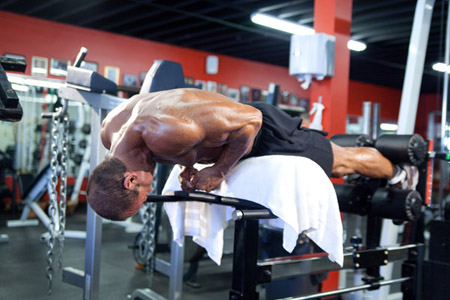
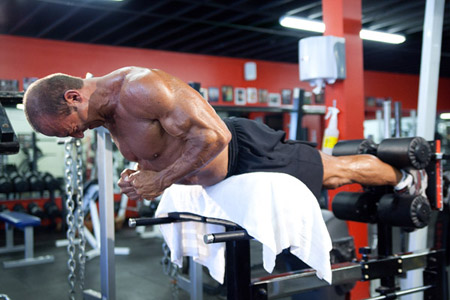
Another way of doing this is with an exercise I call a “Seated Spinal Flexion”. Sit on a bench that is a bit higher than normal, with your feet out on the floor, but farther out than your knees. Hold a weight that is comfortable (a pair of 10 pound dumbbells, for example; I typically use a pair of 20s or 25s). Bend forward, rounding your back – then arch your back without necessarily going all the way up to a vertical position. In other words, try to arch your back while still slanting forward. Repeat for 15 reps. A more advanced version of this exercise is to do it while standing, and bent over (shown below).
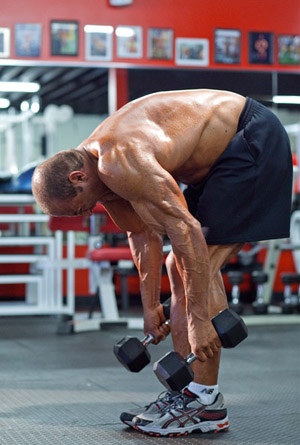
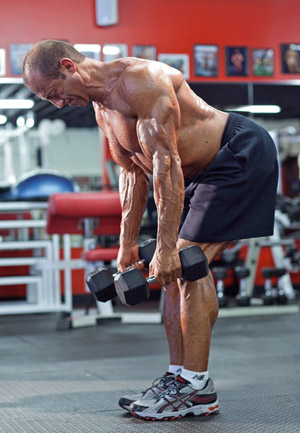
On either version of this exercise (seated or standing), you’ll discover that “where you hold the weight” matters. If you hold them straight down, or pushed slightly forward – it makes the exercise harder (because it magnifies the resistance more, as it lengthens the lever). If you pull the weights back a bit, it will make the exercise easier (because it reduces the resistance, as it it shortens the lever). The goal is not to use a lot of weight; the goal is to isolate the lumbar muscles, with a reasonable resistance. Strive to feel the stretch and contraction of the lower back muscles on each rep, and feel the fatigue there.
Keep in mind that everyone has a different degree of spinal mobility / flexibility. Some people’s spines move very little – forward or backward. Other people’s spines bend too much (…these individuals should avoid the extreme degrees of flexion and extension). But for those of us who have a “normal” amount of spinal flexibility, and no existing damage or injury to our spine, are free to perform these two exercises – with moderate resistance – with a full range of motion. In fact, it’s likely to improve our spinal mobility – as well as providing us with the maximum amount of muscle stimulation and development.
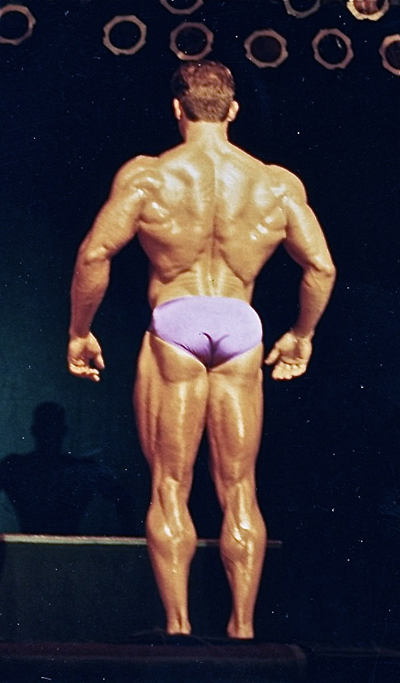
The author - Doug Brignole - at the age of 31, competing in the 1991 Mr. Northwestern America competition.
Exercise demonstration photos of Doug Brignole – at the age of 51 – taken by Michael Neveux, at Dave Fisher’s Powerhouse Gym, in Torrance, California – August 2011.




















You must be logged in to post a comment Login